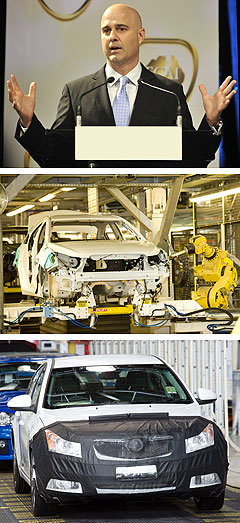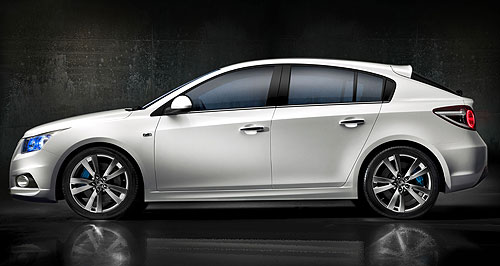Make / Model Search
Future models - Holden - CruzeAIMS: Holden courts Cruze IINext step: The current-generation Cruze hatch has just made its Australian debut, but Holden is already pitching for the design and manufacture of the next-gen model. Hopes high for an Oz-designed next-gen Cruze despite government funding withdrawal4 Jul 2011 EVEN before the first Australian-penned hatch version reaches production in Adelaide, Holden has revealed it is pitching for the design and manufacture of the next-generation Cruze small car. Holden is taking part in a global competition within General Motors to create the look of the 2015 model Cruze, with a decision due by the end of 2012. It is not known whether Holden is presenting proposals for all body variants, but there is a fixed styling theme in place for which the undisclosed number of GM outposts – including the Fishermans Bend design and prototype centre in Melbourne – are working towards. Holden chairman and managing director Mike Devereux revealed the plan at the local debut of the Adelaide-made JH Cruze hatchback – albeit in 2010 Paris motor show concept car rather than in final production guise – at the Melbourne motor show on Friday. “We want to make the next-gen Cruze right here,” he told the media. “It’s actually a spectacular product. All around the world we’re doing sketches. Our team is doing sketches for Cruze … so there will be a design competition for it. I’ve seen the mainstream theme, it’s a killer, and absolutely we want to make it here … we want to make the next Cruze in Adelaide, no question.”  Left: Holden chairman and managing director Mike Devereux. Below: Current Cruze production at Holden's Elizabeth plant. Left: Holden chairman and managing director Mike Devereux. Below: Current Cruze production at Holden's Elizabeth plant.However, the Holden boss took the opportunity to reiterate warnings he had made in late June that the Australian federal government’s decision to drop the $800 million Green Car Innovation Fund (GCIF) could threaten the automotive industry’s long-term viability in Australia, particularly in the light of little or no import taxes depending on where a vehicle is sourced. While denying that his comments were planned as a threat for the government to reinstate the GFIC while Australian federal industry minister Kim Carr was meeting with GM and Ford in Detroit, Mr Devereux did warn that no financial assistance could ultimately undermine Holden’s pitch for the Cruze II project. “The timing (of Minister Carr’s Detroit meeting) is purely coincidental,” he said. “We had no plan to talk about co-investment because Mr Carr was in the States … Kim regularly travels all around the world to visit all the major auto-producing nations. “(But) countries that have low tariff barriers have to have a business plan to attract foreign investment – that is a fact of life in the global auto business. We have five six-year planning cycles for our vehicles, the Cruze that we are showing today has been in production for a couple of years, and we don’t run those things for 10 years, so it’s time for us to figure out what we are going to do with our next one already. “I have to have a business plan for Holden I have to understand what the business plan for the country is. “There is no question that without co-investment the business case for making things in Australia is quite a bit different than if you have co-investment. “There is no question that, without $800 million worth of the GCIF, GM has to take a look at what we are doing here and what the return on what we do here is. My job is to make that case with the government of this country, and to make this case with massive investments with my managers in Detroit. “The first thing we need to do as an industry is to make everybody in the political debate understand both sides of the equation and (make them) aware of the product development cycles, and how long in advance the investment decisions we actually have to make that decision. “And I am not certain that before this week everybody understood that. I lay out what our investment cycles are … how long these things take and the dollars involved, and the alternatives that the global companies have in other places.” Mr Devereux was also keen to point out that GM still rates Holden as a vital centre of development. “My colleagues in Detroit and Shanghai understand how important what we do for the brand is for the company. “We get the fact that we’re Australian because we make things here, and that we have been part of the fabric of the country for a long time. At GM, strategically we want to do things in this country the way we do things today – that is our desire. “(But) if we get rid of very intelligently crafted programs that are long-term, to 2020, which completely takes into account planning cycles, the longevity of these investments and the ability to be able to activate around these investments (because you don’t just make one, there are follow-on investments that you have planned), and then you change by $800 million the ability to activate investments, it’s a big change to the business plan.”  Read moreAll motor show Alfa Romeo Alfa Romeo Abarth Abarth Alpine Alpine Alpina Alpina Audi Audi Aston Martin Aston Martin BMW BMW Bentley Bentley Chery Chery Brabham Brabham Chrysler Chrysler Chevrolet Chevrolet Cupra Cupra Citroen Citroen DS DS Dodge Dodge Fiat Fiat Ferrari Ferrari Foton Foton Ford Ford Great Wall Great Wall FPV FPV Haval Haval GWM GWM Honda Honda Holden Holden Hummer Hummer HSV HSV Infiniti Infiniti Hyundai Hyundai Jaguar Jaguar Isuzu Isuzu Kia Kia Jeep Jeep Land Rover Land Rover Lamborghini Lamborghini Lexus Lexus LDV LDV Mahindra Mahindra Lotus Lotus Mazda Mazda Maserati Maserati Mercedes-AMG Mercedes-AMG McLaren McLaren MG MG Mercedes-Benz Mercedes-Benz Mitsubishi Mitsubishi Mini Mini Opel Opel Nissan Nissan Peugeot Peugeot Pagani Pagani Proton Proton Porsche Porsche Renault Renault Ram Ram Rover Rover Rolls-Royce Rolls-Royce Skoda Skoda Saab Saab SsangYong SsangYong Smart Smart Suzuki Suzuki Subaru Subaru Toyota Toyota Tesla Tesla Volvo VolvoMotor industry news |
Click to shareAll motor show Alfa Romeo Alfa Romeo Abarth Abarth Alpine Alpine Alpina Alpina Audi Audi Aston Martin Aston Martin BMW BMW Bentley Bentley Chery Chery Brabham Brabham Chrysler Chrysler Chevrolet Chevrolet Cupra Cupra Citroen Citroen DS DS Dodge Dodge Fiat Fiat Ferrari Ferrari Foton Foton Ford Ford Great Wall Great Wall FPV FPV Haval Haval GWM GWM Honda Honda Holden Holden Hummer Hummer HSV HSV Infiniti Infiniti Hyundai Hyundai Jaguar Jaguar Isuzu Isuzu Kia Kia Jeep Jeep Land Rover Land Rover Lamborghini Lamborghini Lexus Lexus LDV LDV Mahindra Mahindra Lotus Lotus Mazda Mazda Maserati Maserati Mercedes-AMG Mercedes-AMG McLaren McLaren MG MG Mercedes-Benz Mercedes-Benz Mitsubishi Mitsubishi Mini Mini Opel Opel Nissan Nissan Peugeot Peugeot Pagani Pagani Proton Proton Porsche Porsche Renault Renault Ram Ram Rover Rover Rolls-Royce Rolls-Royce Skoda Skoda Saab Saab SsangYong SsangYong Smart Smart Suzuki Suzuki Subaru Subaru Toyota Toyota Tesla Tesla Volvo VolvoMotor industry news |










Facebook Twitter Instagram